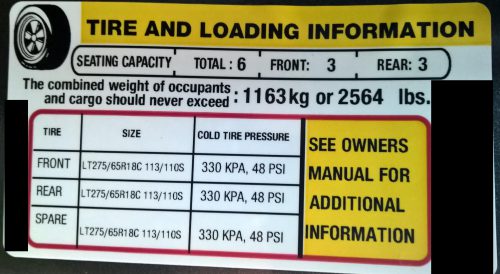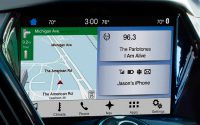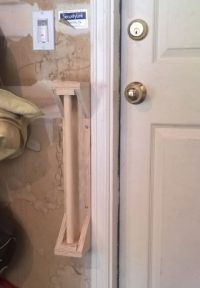How much weight can that truck haul? How much can it tow? I had very little idea how to really answer those questions before I started researching my truck purchase. I figured there was a web page somewhere that you could look it up and figure it out. And that’s sort of correct, but that web page is huge and complicated. Plus it varies by vehicle depending on the options that you chose. So how do you figure it out?
All of the info you need is printed on the inside door frame of the driver’s door. The first sticker of interest is white with black lettering. The key numbers are:
- GVWR (gross vehicle weight rating): No matter what you load into your truck, it should never weigh more than this.
- GAWR (gross axle weight rating): There is one number for the front axle and one for the rear. This just means that you can’t take that full GVWR and put it all on the back of your truck. You need to have the weight distributed so that the front and rear axles carry loads they can handle.
The second sticker is white with yellow, red and black. The main information there is the correct tire pressures but it also tells you “The combined weight of occupants and cargo should never exceed X.”
The one important number that I can’t find anywhere on the stickers is GCWR (gross combination weight rating.) This the maximum weight of the truck and the trailer with everything loaded into it. Along with the payload rating, it helps you determine how heavy your trailer can be. All I have for that is the spec sheet published by Ford.
The images in this post are from my truck and you can see that my payload is 2564 lbs and that number is the reason why I had to wait so long to get my truck. If you don’t get the heavy duty payload package on the F150, you’re probably going to have something like 1500-1900 pounds of payload capacity.
Those numbers might sound really high but they get eaten up very quickly. For example, let’s say the driver is 200 pounds and there are 300 pounds of other humans in the vehicle. That’s 500 pounds gone from your payload. Oh and you got a spray in bedliner? That’s about another 80 pounds. Then add up all the luggage and gear that you packed for your trip and include that. If you’re towing a trailer, the tongue weight of the trailer comes out of your payload allotment too. If you take the calculate the total weight of the trailer (including all the stuff you have in it too), about 10% of that will be carried by your truck. If you want to be extra careful, load your vehicle up with all your gear, hitch up your trailer, and get it weighed.
Now obviously your vehicle isn’t going to fall apart if you exceed the payload capacity, but it’s probably a good idea to know what the stickers say and then know how far you’re exceeding it. Going 100 pounds over is almost certainly fine. Going 2000 pounds over is probably a recipe for disaster.
So in the end, my truck can handle 2500 pounds and can pull 11,400 pounds. That should be plenty for the commute back and forth to my desk at work…








 As I researched the possibility of ordering a new truck last year, I thought I’d save some money by skipping the Sync system. We have it on the Escape and, while it’s functional, it’s not WOW and for the extra cost, it should be at least 72% more wow. Then I heard that the 2016 F150s would be receiving the brand new Sync 3 system. It’s a complete overhaul and a break from the Microsoft system. The early reviews were very good so I went for it. So far, I’m glad I did. My main beef with Sync 2 is that it’s sluggish. Sync 3 is very responsive. I can pinch to zoom and get much faster reactions to touch selections.
As I researched the possibility of ordering a new truck last year, I thought I’d save some money by skipping the Sync system. We have it on the Escape and, while it’s functional, it’s not WOW and for the extra cost, it should be at least 72% more wow. Then I heard that the 2016 F150s would be receiving the brand new Sync 3 system. It’s a complete overhaul and a break from the Microsoft system. The early reviews were very good so I went for it. So far, I’m glad I did. My main beef with Sync 2 is that it’s sluggish. Sync 3 is very responsive. I can pinch to zoom and get much faster reactions to touch selections.

 The door to our garage has a spring in the hinge so it closes automatically. That’s generally handy but I’m waiting for it to smash Elijah’s hand. He has to hold onto the door frame to step down. So to help keep all his fingers attached, I pulled out some scrap wood and built a little hand hold for him. It was a one night project using an old broom stick as the round piece to grip and so far it’s working out really well.
The door to our garage has a spring in the hinge so it closes automatically. That’s generally handy but I’m waiting for it to smash Elijah’s hand. He has to hold onto the door frame to step down. So to help keep all his fingers attached, I pulled out some scrap wood and built a little hand hold for him. It was a one night project using an old broom stick as the round piece to grip and so far it’s working out really well.


Church Shirts
I’ve been at my current church for over 10 years and for most of those 10 years I’ve heard people talk about how nice it would be to have custom shirts. The preschool and kindergarten kids could wear them on field trips, volunteers could wear them during events, and we could use them as jerseys at the softball tournament.
This year it finally happened. I ordered from a local company called Image Source. Beth came up with the idea for the design and I got it all cleaned up for the printers. It’s loosely based on our “official” church logo.